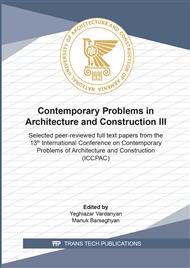[1]
I. Takeshi, G. Arild, P.J .Bjørn, Effect of facade components on energy efficiency in office buildings, Applied Energy․ 158 (2015) 422–432․.
DOI: 10.1016/j.apenergy.2015.08.074
Google Scholar
[2]
B․P․ Jelle, A․ Hynd, A․ Gustavsen, D․ Arasteh, H․ Goudey, R. Hart, Fenestration of today and tomorrow: a state-of-the-art review and future research opportunities, Sol. Energy Mater. and Sol. Cells․ 96 (2012) 1-28.
DOI: 10.1016/j.solmat.2011.08.010
Google Scholar
[3]
S.E. Kalnæs, B.P. Jelle, Vacuum insulation panel products: A state-of-the-art review and future research pathways, Applied Energy. 116 (2014) 355-375.
DOI: 10.1016/j.apenergy.2013.11.032
Google Scholar
[4]
B.P. Jelle, Traditional, state-of-the-art and future thermal building insulation materials and solutions - properties, requirements and possibilities, Energy and Buildings. 43-10 (2011) 2549-2563.
DOI: 10.1016/j.enbuild.2011.05.015
Google Scholar
[5]
A.S. Muhaisen, M.B. Gadi, Effect of courtyard proportions on solar heat gain and energy requirement in the temperate climate of Rome, Building and Environment. 41-3 (2006) 245-253.
DOI: 10.1016/j.buildenv.2005.01.031
Google Scholar
[6]
W.J. Parker, R.J. Jenkins, C.P. Butler, G.L. Abbott, Flash method of determining thermal diffusivity, heat capacity and thermal conductivity, Journal of Applied Physics. 32-9 (1961).
DOI: 10.1063/1.1728417
Google Scholar
[7]
J.Blumm, J.Opfermann, Improvement of the mathematical modeling of flash measurements, High Temperatures - High Pressures. 34-5 (2002) 515-521.
DOI: 10.1068/htjr061
Google Scholar
[8]
D.R. Lide. Handbook of Chemistry and Physics, 90th ed., CRC Press, Boca Raton, Florida, (2009).
Google Scholar
[9]
A.K. Karamyan, et al., Method for determining the thermophysical characteristics of materials", Inventor,s certificate N1636752, 1988 (in Russian).
Google Scholar
[10]
Construction Norms RACN 24-01-2016 Thermal Protection of Buildings,, 63 pages, ISBN 978-9939-1-0421-8.
Google Scholar
[11]
Construction Norms RACN II-7.02-95 Building Thermophysics of fencing constructions,.
Google Scholar
[12]
I. Nardi, D. Ambrosini, T. de Rubeis, S. Sfarra, S. Perilli, G. Pasqualoni, A comparison between thermographic and flow-meter methods for the evaluation of thermal transmittance of different wall constructions, Journal of Physics: Conference Series, Volume 655, 33rd UIT (Italian Union of Thermo-fluid dynamics) Heat Transfer Conference 22–24 June 2015, L'Aquila, Italy.
DOI: 10.1088/1742-6596/655/1/012007
Google Scholar
[13]
V. Casalegno, P. Vavassori, M. Valle, M. Ferraris, M. Salvo, G. Pintsuk, Measurement of thermal properties of a ceramic/metal joint by laser flash method, Journal of Nuclear Materials. 407-2 (2010) 83-87.
DOI: 10.1016/j.jnucmat.2010.09.032
Google Scholar
[14]
Information on https://www.engineeringtoolbox.com/.
Google Scholar
[15]
Information on https://www.researchgate.net/publication/299979249_Search_for_the_optimal_ window-to-wall_ratio_in_office_buildings_in_different_European_climates_and_the_implications_ on_total_energy_saving_potential.
DOI: 10.1016/j.solener.2016.03.031
Google Scholar
[16]
D.Pan, M.Chan, S.Deng, Z.Lin, The effects of external wall insulation thickness on annual cooling and heating energy uses under different climates, Applied Energy. 97 (2012) 313-318.
DOI: 10.1016/j.apenergy.2011.12.009
Google Scholar
[17]
K. Tsikaloudaki, K. Laskos, T. Theodosiou, D. Bikas, Assessing cooling energy performance of windows for office buildings in the Mediterranean zone, Energy and Buildings. 49 (2012) 192–199.
DOI: 10.1016/j.enbuild.2012.02.004
Google Scholar
[18]
T.Theodosiou, K.Tsikaloudaki, D.Bikas, Analysis of the thermal bridging effect on ventilated facades, Procedia Environmental Sciences. 38 (2017) 397-404.
DOI: 10.1016/j.proenv.2017.03.121
Google Scholar
[20]
Information on https://www. smartcalc.ru/.
Google Scholar
[21]
Information on http://www.stroypribor.com/.
Google Scholar


